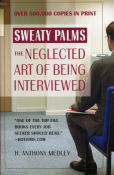| What REALLY goes on in a job interview? Find out in the new revision of "Sweaty Palms: The Neglected Art of Being Interviewed" (Warner Books) by Tony Medley, updated for the world of the Internet . Over 500,000 copies in print and the only book on the job interview written by an experienced interviewer, one who has conducted thousands of interviews. This is the truth, not the ivory tower speculations of those who write but have no actual experience. "One of the top five books every job seeker should read," says Hotjobs.com. | |
| Bobby (3/10) by Tony Medley This is not a biopic of Bobby Kennedy. Oh, there are some vintage film clips of some of Bobby’s speeches, and the final montage is shown under a voice-over of Bobby talking about civility. Except for that, It’s not about Bobby Kennedy. The most offensive part of the film is the presence of Harry Belafonte, who plays a hotel retiree, in the cast. There is no reason for Belafonte’s role, so there’s no explanation as to why he is in the cast. His presence is an affront to what this movie proclaims was Bobby Kennedy’s main theme of his 1968 campaign for the Presidency, civility and treating others with respect. Belafonte is the direct antithesis of this philosophy. He has become notorious for his bellicose manner in verbally castigating both President Bush and the United States, even cozying up to the two biggest anti-American tyrants in the hemisphere, Fidel Castro of Cuba and Hugo Chavez of Venezuela. Another gaffe occurs when one of the busboys is listening to a Dodgers baseball game, as Don Drysdale was pitching his sixth consecutive shutout the night Kennedy was shot. When the Dodgers moved to Los Angeles in 1958 they brought with them announcer Vin Scully, who has been the Most Valuable Dodger ever since. But the voice calling the game wasn’t Vinnie’s, or even that of Jerry Dogget, Scully’s number two man who called two innings of every game (the third and the seventh). If writer/director Emilio Estevez wanted to capture the ambience of Los Angeles and wanted to use a Dodgers game to do it, he can’t do it without Vin Scully. Maybe Vin and the Dodgers didn’t want to cooperate. “Bobby” is of a genre that could be called “Altman-light,” which is damning for me to say because I’m not a fan of Robert’s (1975’s “Nashville,” 2001’s “Gosford Park,” 2006’s “The Prairie Home Companion,” to name just three of his critically-acclaimed films that I didn’t like). In the style of Altman, Estevez chooses to tell the story of 22 fictional characters placed at the Ambassador the night Kennedy was shot. It starts in the morning and cuts back and forth among several people, played by stars like Estevez’s father, Martin Sheen, honeymooning with his much younger wife, Helen Hunt, Demi Moore, who plays drunken chanteuse Virginia Fallon starring at the Cocoanut Grove and there to introduce Bobby at the party that night (Estevez plays her husband, Tim), Ashton Kutcher, Demi’s husband and an actor I admire, playing Fisher, a drug dealer, Laurence Fishburne, playing Edward Robinson, an Ambassador Hotel sous chef (Edward Robinson? Is there some obscure reason Estevez chose that name, so similar to actor Edward G. Robinson?), Wiliam H. Macy, playing hotel manager Paul Ebbers, Sharon Stone, playing his wife, Miriam, and Anthony Hopkins, who co-produced, playing a retired doorman, among many others. None of these characters ever lived. Why Estevez chose to make this totally fictional is puzzling because five real people were shot the night Kennedy was assassinated. Why invent people when Estevez could have told authentic stories about genuine people? In so doing, he might have brought some meaning into their lives for the tragedy they suffered through. It would have had the added extra value of being truthful. Apparently Estevez (who was only seven years old in 1968 when the event occurred) wasn’t interested in that. One thing for which Estevez should be congratulated is filming this with so many Hollywood luminaries on a skimpy budget of around $6 million. Maybe Estevez isn’t a great filmmaker, but he’s evidently not a bad businessman. Maybe hampered by his budget restraints he does a disappointing job of recreating the legendary Cocoanut Grove, although how much could a couple of fake palm trees cost? The essence of the movie is that we follow the various characters, all waiting for the results of the 1968 California Primary Election and Bobby Kennedy’s appearance at the end of the day. I found it an excruciatingly slow, uninvolving, story of a bunch of imaginary people about which I cared not a whit. The closing credits are shown over some interesting pictures of Bobby and his family. When I saw it, the film was still being cut. It ran around 1:50. If you arrive at around the 1:45 mark, you won’t miss anything and you’ll get to see the photos. November 14, 2006
|
|
|
|
|
